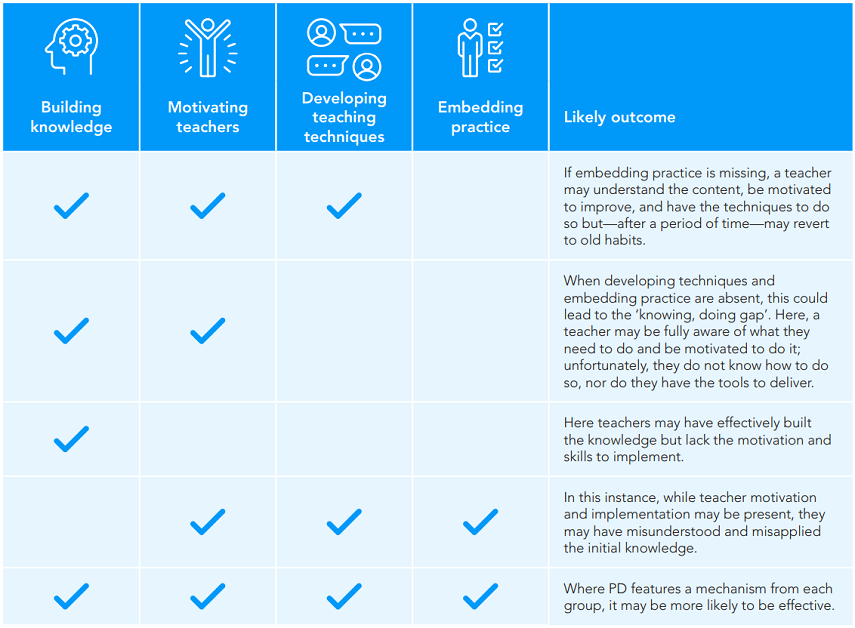No matter the context of a school, it’s the quality of teaching that can make the biggest in-school difference to students’ learning and ultimately their success (Hattie, 2003). What’s more, the quality of teaching is not fixed: teaching can improve through effective professional development (Rauch & Coe, 2019).
Teacher professional development (PD) has great potential; but it also comes with costs. When teachers engage in PD, they are also balancing multiple and, at times, competing commitments and time pressures. As such, PD needs to be well-designed, selected, and implemented so that the investment is used well. The effective use of PD investment is particularly critical at a time when schools are facing workforce shortages and workload concerns (Hunter et al., 2022).
Evidence for Learning’s (E4L) latest Guidance Report, Effective Professional Development, shifts the conversation of effective professional development away from one of ‘format’ and highlights the ‘mechanisms’ of professional development that are likely to have an impact in the classroom.
This article draws heavily on 2 key sources. The first is a systematic review of the characteristics of effective PD published in 2021 (Sims et al., 2021), and the second is E4L’s subsequent Guidance Report (Evidence for Learning, 2022), which provides actionable recommendations for school leaders which have been distilled from the systematic review.
What is teacher professional development?
The language ‘PD’ is used in this article and was the focus of the research which underpins the recommendations in the Guidance Report (Sims et al., 2021). Table 1 provides examples of what constitutes PD, and what does not.

Table 1: What professional development is, and is not…
What does the evidence say?
The average impact of PD is positive, however the effects on student outcomes can vary from having a very positive to negative impact. To date, there has been a gap in the evidence about exactly how PD should be delivered. The Guidance Report points to the role of mechanisms within PD, which are the crucial elements that lead to impact.
The mechanisms are underpinned by findings from the systematic review of the latest global research evidence on PD. The review looked at studies where PD had a positive effect on student outcomes, and identified their features, or active ingredients – in other words, the mechanisms of effective PD.
The Guidance Report shares 3 recommendations for school leaders considering effective PD in their settings:
- When designing and selecting PD, focus on the mechanisms.
- Ensure that PD effectively builds knowledge, motivates staff, develops teaching techniques, and embeds practice.
- Implement PD programs with care, taking into consideration the context and needs of the school.
Each recommendation builds on the concepts of mechanisms and the importance of a balanced design – these 2 concepts are explored further below.
What are the categories and mechanisms of effective PD?
The 14 mechanisms of effective professional development fall into 4 categories:
A. Build knowledge
B. Motivate teachers
C. Develop teaching techniques
D. Embed practice

As any teacher would with their own class, those designing and facilitating PD must pay close attention to how they structure and build knowledge to support understanding.
The first mechanism to build knowledge is managing cognitive load. ‘Human cognitive processing is heavily constrained by our limited working memory, which can only process a limited number of information elements at a time’ (Sweller et al., 2019), so using strategies that reduce the strain on these processes can promote better learning. These might include avoiding overload; focusing on the most relevant content; or using multiple examples and varied content.
Another important consideration when structuring the knowledge taught to teachers in PD is the relationship with previous and future learning. This draws upon research relating to retrieval practice (Leggett et al., 2021), which theorises that recalling information makes it more likely that the learner will retain the learning.

Once knowledge has been built, motivation to act upon that knowledge comes into play. Three mechanisms can help with motivation: setting and agreeing on goals, presenting information from a credible source, and providing affirmation and reinforcement after progress.
Goal setting can substantially increase the likelihood of behaviour change, which is a key outcome of PD. When conscious, specific, and sufficiently difficult goals are set, they make it more likely that performance will improve, and the goal will be achieved.
When it comes to information sources, teachers are motivated by credibility, so the case for changing practice should be presented carefully and backed by credible, relevant evidence.
When progress has been made in altering practice, affirmation and reinforcement may improve teachers’ motivation to continue acting on what they have learnt from PD.

Effective PD is likely to provide teachers with the techniques they need to improve their practice. After building knowledge, and then being motivated to act upon it, these 5 mechanisms outlined in the illustration above provide the tools required to develop teaching techniques and change practice.
Central to effective PD is the delivery of well-thought-out guided instruction, which is grounded in evidence and supports teachers to develop effective techniques. Along with clear and considered instruction, peer support may scaffold development as colleagues often share common language, culture, and knowledge and may be able to provide emotional or informational assistance.
PD that includes modelling techniques, such as observable samples of performance for reflection or imitation, can support teachers to learn that technique. Moving on from modelling, feedback is associated with a positive effect on performance, on average, and can be included in PD through coaching, observations and follow up.
Finally, prompt practice and rehearsal of a technique, at least once in a context outside of the classroom (such as a role play with colleagues during PD) may support teachers in enhancing their skills and embedding habits.


Once teachers have built their knowledge, are feeling motivated, and have the relevant techniques, mechanisms to support them effectively embed practice for lasting behaviour change are needed.
Prompts that nudge and remind teachers to carry out agreed actions or behaviours can help to alter practice over time and can be as simple as a fortnightly email reminder.
Supporting teachers to develop an action plan that includes how a technique will be implemented can assist with the likelihood of implementation. Building on an action plan, encouraging self-monitoring can help teachers examine and record their performance and progress. Self-regulation theory suggests that recording and self-monitoring can make effective habit formation more likely because it forces teachers to pay specific attention to their actions and effects.
Finally, context-specific repetition where teachers rehearse and repeat behaviour in the classroom at least twice can support embedding practice.
A balanced design
Effective PD programs included in the systematic review had a commonality – the more mechanisms a PD program had, the greater the impact on student outcomes. However, effective PD can’t be treated as a ‘tick box’ activity and mechanisms should be considered within the context of implementation and overall quality of PD. A useful guide is to look for ‘balanced design’ to ensure at least one mechanism from each of the 4 groups is included. If one or more group is missing, the program may fail for a particular reason, as detailed in Table 2 below.

Table 2: Exploring a balanced design
A reflection activity
With a colleague, discuss how you will use your knowledge of mechanisms to select and/or design PD in the future. You may wish to consider the following prompts with your school’s context and students’ needs in mind.
- Build knowledge: How can we effectively manage the cognitive load of teachers? How can we revisit prior learning to embed understanding?
- Motivate staff: How can we encourage teachers to set and agree on goals? How can we ensure information is from a credible source? How can we offer affirmation and reinforcement after progress?
- Develop teaching techniques: How can we best instruct teachers on how to perform a specific teaching technique? What practical support needs to be offered (e.g. coaching)? How can we offer purposeful feedback on practice? Are there opportunities to rehearse the teaching technique?
- Embed practice: How can we provide useful prompts and cues that helpfully nudge teachers? How can we prompt productive action planning? How can we encourage self-monitoring? How can we prompt context-specific repetition to embed practices?
Stay tuned: How do you remove an approach or program that is no longer meeting student and school needs? Next week, Susannah Schoeffel and Michael Rosenbrock will look at de-implementation: what it is, the benefits it may bring, and what good de-implementation looks like.
References and further reading
Evidence for Learning. (2022). Effective Professional Development. Sydney: Evidence for Learning. https://evidenceforlearning.org.au/education-evidence/guidance-reports/effective-professional-development
Hattie, J. (2003, October). Teachers make a difference: What is the research evidence? Paper presented at the Building Teacher Quality: What does the research tell us ACER Research Conference, Melbourne, Australia. http://research.acer.edu.au/re...;
Hunter, J., Sonnemann, J., & Joiner, R. (2022). Making time for great teaching: How better government policy can help. Grattan Institute. https://grattan.edu.au/report/making-time-for-great-teaching-how-better-government-policy-can-help/
Leggett, J. M. I., Burt, J. S., & Carrol, A. (2019). Retrieval practice can improve classroom review despite low practice test performance. Applied Cognitive Psychology. 33(5), p 759-770. https://onlinelibrary.wiley.com/doi/abs/10.1002/acp.3517
Rauch, C.J., & Coe, R. (2019). Evaluating and Measuring Teaching Quality in Teacher CPD: International Trends, Opportunities and Challenges. Chartered College of Teaching. https://chartered.college/download-international-teacher-cpd-report/
Sims, S., Fletcher-Wood, H., O’Mara-Eves, A., Cottingham, S., Stansfield, C., Van Herwegen, J., & Anders, J. (2021). What are the characteristics of teacher professional development? A systematic review and meta-analysis. Education Endowment Foundation. https://educationendowmentfoundation.org.uk/education-evidence/evidence-reviews/teacher-professional-development-characteristics
Sweller, J., van Merriënboer, J. J., & Paas, F. (2019). Cognitive architecture and instructional design: 20 years later. Educational Psychology Review. 31(2), p 261–292. https://link.springer.com/article/10.1007/s10648-019-09465-5
The Effective Professional Development page on E4L’s website includes the Guidance Report as well as additional tools and templates to support your planning.



